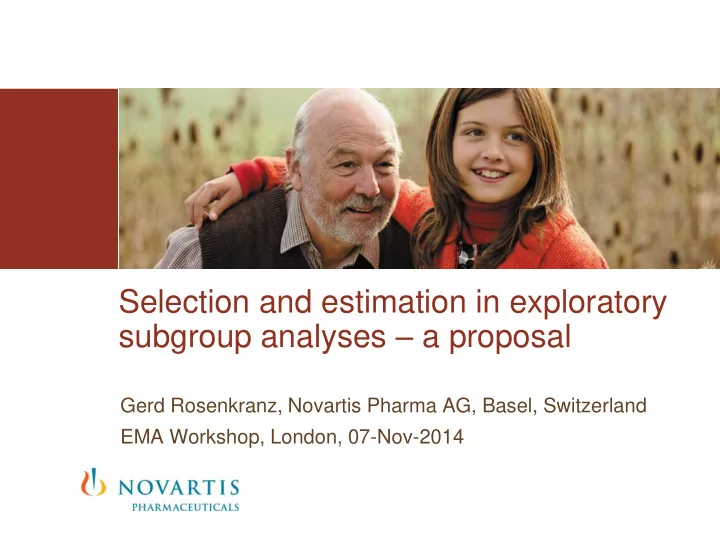

Selection and estimation in exploratory subgroup analyses – a proposal Gerd Rosenkranz, Novartis Pharma AG, Basel, Switzerland EMA Workshop, London, 07-Nov-2014
Purpose of this presentation Proposal for exploratory subgroup analyses • Favoring estimation over tests and/or p-values Identification of subgroups with differing efficacy (‘predictive subgroups’) as an integral part of analysis • Accounting for subgroup selection uncertainty and selection bias Discussion of properties, limitations and extensions General remark: The potential of any method of subgroup analysis is limited by the information content of the data 2 | EMA Workshop | GR | 07-Nov-2014 | Exploratory subgroup analysis
Definition of Subgroups Draft EMA Guideline on Subgroups in confirmatory trials, Section 4.1 A subgroup can be defined as any subset of the recruited patient population that fall into the same category (level) with regard to one or more descriptive factors prior to randomization Factors may relate to • Demographic characterstics (e.g., age, gender, race) • Disease characteristics (e.g., time of diagnosis, severity) • Clinical considerations (e.g., region, concomitant medication) Subgroups defined by different factors may overlap Sufficient to consider subgroups based on a single factor in most cases 3 | EMA Workshop | GR | 07-Nov-2014 | Exploratory subgroup analysis
Consistency Evidence for lack of consistency if at least one subgroup can be identified where the effect of test treatment over control differs • from the overall effect or, equivalently, • between subgroup and its complement How to identify subgroups without too much risk of chance findings or incorrect selections? How to estimate the effect in the identified subgroups without too much bias? What constitutes sufficient evidence of consistency is less obvious 4 | EMA Workshop | GR | 07-Nov-2014 | Exploratory subgroup analysis
A modeling approach for subgroup identification Assume subgroups can be defined in terms of factors with two levels , that is, each factor divides the patient population into two subgroups like • Gender: male, female • Age group: ≤ 65𝑧, > 65𝑧 List of candidate factors available Turn subgroup identification into model selection • For each candidate factor, fit a statistical model including a term that reflects the amount by which the difference in treatment arms is influenced by the factor • Select the model providing the best fit and estimate the amount by which the difference in treatment arms is influenced by the factor 5 | EMA Workshop | GR | 07-Nov-2014 | Exploratory subgroup analysis
A modeling approach for subgroup identification Drawbacks • Does not account for model selection uncertainty • May result in biased estimates (driven by search for the best fit) • Small changes of data may result in substantially different results Better but expensive approach: • Identify factor corresponding to best fit in a series of studies • Note how often different factors are identified • Aggregate estimates across studies Consider re-sampling instead 6 | EMA Workshop | GR | 07-Nov-2014 | Exploratory subgroup analysis
A modeling approach for subgroup identification 1. Sample with replacement (by treatment) from original data 2. Identify model with best fit to sample 3. Obtain estimates from that model 4. Repeat steps 1 – 3 above many times 5. Select the factor belonging to the most frequently selected model (‘voting’) 6. Obtain (biased-reduced) parameter estimates for that selection from the samples 7 | EMA Workshop | GR | 07-Nov-2014 | Exploratory subgroup analysis
Simulations Assumptions • Normally distributed data with 𝜏 = 1 • Overall difference between test and control: 0.5 • 90% power, 𝛽 = 0.00125 (two trials in one) • 1:1 randomization • 166 subjects per treatment • Two predictive factors: ‘gender’ and ‘age group’, such that each gender – age group combination accounts for 25% of subjects • Three unpredictive factors called random1, random2, random3 that mark subgroups randomly • Effect of control = 0 (regardless of subgroups) • Effect of test treatment in subgroups on following slides • 500 simulated studies with 200 re-samples each 8 | EMA Workshop | GR | 07-Nov-2014 | Exploratory subgroup analysis
Simulation results Consistent effects Consistent mean effect Gender Marginal Difference of test treatment 0 1 0 0.5 0.5 0.5 Age group 0.0 1 0.5 0.5 0.5 Marginal 0.5 0.5 0.5 Difference 0.0 Factor Frequency of True marginal Estimator Bias-reduced selection (%) difference estimator Age group 21.0 0.0 -0.02(0.35) -0.02(0.25) Gender 18.0 0.0 -0.06(0.29) -0.05(0.21) Random 1 19.8 0.0 0.07(0.34) 0.04(0.21) Random 2 19.0 0.0 0.02(0.38) 0.02(0.27) Random 3 22.2 0.0 0.01(0.40) 0.02(0.28) 9 | EMA Workshop | GR | 07-Nov-2014 | Exploratory subgroup analysis
Simulation results Inconsistent effects Inconsistent mean Gender Marginal Difference effect of test treatment 0 1 0 0.2 0.4 0.3 Age group 0.4 1 0.5 0.9 0.7 Marginal 0.35 0.65 0.5 Difference 0.3 Factor Frequency of True marginal Estimate Bias-reduced selection (%) difference estimate Disease status 61.6 0.4 0.48(0.21) 0.41(0.21) Gender 27.0 0.3 0.45(0.25) 0.37(0.23) Random 1 3.8 0.0 -0.03(0.45) -0.01(0.35) Random 2 2.8 0.0 -0.15(0.39) -0.12(0.30) Random 3 4.8 0.0 0.03(0.55) 0.02(0.42) 10 | EMA Workshop | GR | 07-Nov-2014 | Exploratory subgroup analysis
Remarks Approach can be extended to • Binary and (ordered) categorical endpoints • Continuous factors (covariates) Need to account for subgroups defined by more than one factor if effect in a subgroup strongly affected by another factor: 11 | EMA Workshop | GR | 07-Nov-2014 | Exploratory subgroup analysis
Outlook Proposed method can be further extended to derive a predictor for the effect of treatment in a future patient Can use the factor values directly – no need to artificially dichotomize numerical factors (like age, BMI) to define subgroups with all its disadvantages Predicted effect size under alternative treatments and measure of prediction uncertainty can support physician’s decision on how to treat a patient 12 | EMA Workshop | GR | 07-Nov-2014 | Exploratory subgroup analysis
Recommend
More recommend